Stephen Morris's Blog, page 32
July 3, 2017
Doppelgängers and Dolly the Sheep
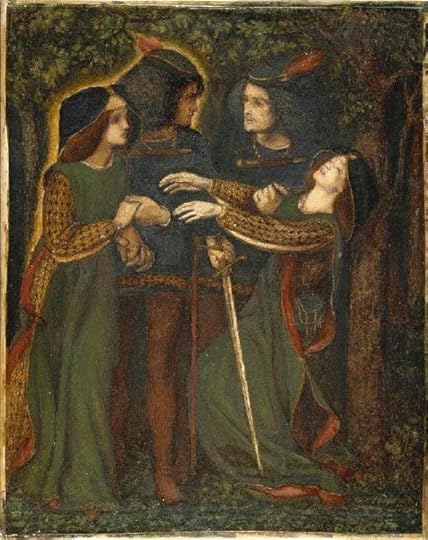
Dante Gabriel Rossetti, “How They Met Themselves,” watercolor, 1864
The first cloning of an animal by scientists was revealed on July 5, 1996 by the Roslin Institute in Scotland when DOLLY THE SHEEP was cloned from tissue taken from a 6 year old ewe’s udder.
But the idea of such a copy or perfect duplicate of a person, often known as a doppelgänger, is an ancient one in folklore and mythology. Ancient Egyptians believed that a “spirit double” could be formed by magicians and that this new entity would share all the same memories of the original. In Greek mythology, Narcissus fell in love with his own reflection and died. German and Norse folklore thought that if your double was seen, this meant that you were about to die. Discovering your double was NOT a good thing! Meeting yourself going the other direction can lead only to destruction.
Rosetti’s watercolor, How They Met Themselves, illustrates the notion that meeting yourself means that you are about to die. In the painting, a pair of lovers meet themselves and the original woman faints with shock. (In real life, the woman who posed for this character died about two years after this painting was finished.) In his later life, Rossetti filled his home with mirrors so that he and his guests were constantly encountering themselves going the other way.
In Irish folklore so popular with the pre-Raphealites, a “fetch” is a supernatural double or an apparition of a living person. Meeting a fetch is regarded as an omen, usually of impending death.
The origin of the Irish word for the duplicate person is obscure. It may derive from the verb “fetch,” as in the compound “fetch-life”, evidently referring to a psychopomp who “fetches” the souls of the dying, which is attested in Richard Stanyhurst’s 1583 translation of the Aeneid. Alternately, the word may derive from fæcce, which is glossed for mære, a spirit associated with death and nightmares.
I remember that when newspapers announced Dolly’s existence, many people claimed that the cloned sheep was a nightmare-come-to-life and was a harbinger of many other Frankenstein-like horrors about to be unleashed onto the world. Those predictions have thankfully proved false–so far!
The post Doppelgängers and Dolly the Sheep appeared first on Stephen Morris, author.
June 26, 2017
Dreams and Visions of the Night
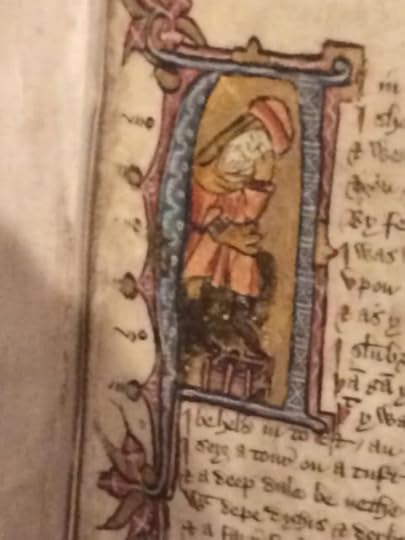
“Piers Plowman,” considered by many to be one of the greatest works of medieval English literature, tells the story of a series of dreams experienced by Piers (Peter) the Plowman. This image is the only known depiction of Piers and shows him dreaming; the manuscript comes from the late 1300s and belongs to Corpus Christi College, Oxford.
Dreams and visions while sleeping have long fascinated us. Modern psychologists use dreams to help us unlock the mysteries of our inner emotional life: what frightens us, what do we yearn for, how do we see ourselves in relation to those around us, who is important to us and why. To ancient and medieval people, dreams were glimpses into the future and ways to travel far without leaving the comfort of our beds.
In Stranger Magic: Charmed States and the Arabian Nights, Marina Warner tells us that “Oneiromancy, or divination through dreams, was a practice throughout the ancient world and cultivated in Egypt: Joseph interprets dreams in both the Old Testament (Genesis 40-41) and the Koran (Sura 12).” Many features of dreams–suddenness and vividness, fragmentation, episodic structures, displacements in time and space, instability of bodies–are common throughout fairy tales and legends of all people.
In stories such as the Arabian Nights, fairy tales, or Piers Plowman, dreams can reveal something true that is happening now or is about to happen. Dream experiences can actually take place and dreamers can awake with a new ring or some token that convinces them that the dream experience actually happened.
The interaction and interrelationship of reality and dreams is explored in modern films as well as legends or tales. Marina Warner suggests that both The Matrix (1999) and Inception (2010) depict one dream world inside another “until the notion of verifiable reality disappears into an abyss of multiple reflections.”
We sing with children, “Row, row, row your boat… life is but a dream,” but dreams can illuminate aspects of our lives that would remain otherwise dark, unexplored, unacknowledged–and therefore all the more powerful over us. I know that if I focus on the emotional content of my dreams — rather than the surface elements that are not always recognizable — that I can appreciate and come to grips with something my sleeping mind is struggling to grapple with. By dreaming and by acknowledging our dreams we can be free of those dark forces and choose our own paths forward.
The post Dreams and Visions of the Night appeared first on Stephen Morris, author.
June 19, 2017
Midsummer 2017

A bonfire for Midsummer in Mäntsälä, Finland.
The summer solstice, more commonly known as Midsummer, marked the longest day of the year and the zenith of magical power often called “white magic.” Magic worked on Midsummer was most often concerned with life and fertility. Jumping through the Midsummer bonfire was a way to attract fertility, good luck, and prosperity to both the jumper and the surrounding fields. The bonfires of Midsummer are traditionally kindled from the friction of two sacred woods, fir and oak. Nine different types of herbs are thrown upon the Midsummer fire: mistletoe, vervain, St. John’s Wort, heartsease, lavender, and a choice of four others chosen from herbs typical of this season such as yarrow. Folks would feast, dance and jump the fire for luck and fertility. The herds were driven through the embers in days long ago to purge disease and illness from them. When the fires had burned down, folks would carry ashes back to their homes to sprinkle on fields, the four corners, and lay embers on the hearth. The ashes bring powers of protection, health and luck.
Water is the other important aspect of Midsummer. In times past folks swam in waters that flowed towards the rising sun as it climbed in Midsummer morning sky. Bathing in springs and rivers on Midsummer brings healing, cleansing and protection. The dew of Midsummer is said to bestow health to whomever drinks of it. Especially powerful is fetching running water of Midsummer morn and mixing it with ashes from the bonfire, sprinkling it around the house, yard and on oneself bestows protection and luck. Iceland combined the beliefs about bathing and dew into one practice: Icelandic folklore says that if you bathe naked in the morning dew on the morning of June 24, you will keep aging at bay for longer.) Midsummer Eve, the night before the solstice, is the evening of herbs. The herbs and flowers gathered this night are considered exceptionally potent. St John’s Wort, burdock, thorn, and nettle , should be harvested on Midsummer Eve and hung on doors or windows and placed around the home for protection. Royal Fern seeds which are gathered at midsummer are said to make the possessor invisible. They who find Royal Fern blossoms on Midsummer’s eve become wise, lucky, and wealthy. Women wear braided circlets of clover and flowers, while men wear chaplets of oak leaves and flowers around their heads. In times past, livestock were also decorated with garlands made of flowers, foliage, and oak leaves.
The post Midsummer 2017 appeared first on Stephen Morris, author.
June 12, 2017
Napoleon of Notting Hill
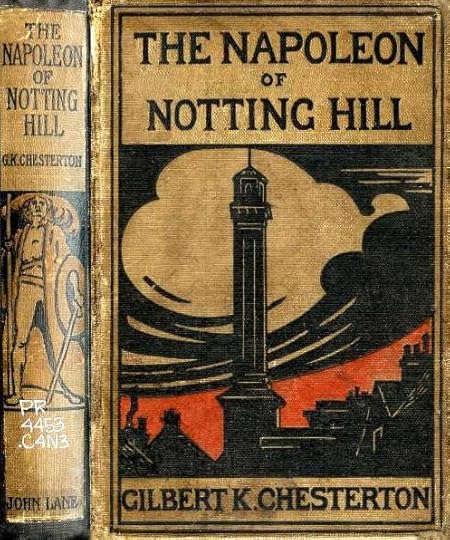
G.K. Chesterton published “The Napoleon of Notting Hill” in 1904.
Picture a London in the future where democracy is dead. A little government minister with virtually no experience governing is made King. The boroughs are suddenly declared separate kingdoms with their own city guard, banner and gathering cry and the capital is plunged into a strange type medieval warfare. Then Notting Hill declares its independence?
When G.K. Chesterton wrote his classic Napoleon of Notting Hill in 1904, the Russo-Japanese War was just beginning and the first ever New Year’s Eve celebration in Times Square was held. Edward VII sat on the British throne. But it is a book surprisingly relevant to the contemporary world. The book revolves around loyalty to the local and taking our neighbors seriously; it is an early demonstration of the axiom, “Think globally, act locally!” But this loyalty to our neighborhood is far from the cries of “America first!” that involve turning our back on the rest of the world. It is our loyalty to our neighborhood that forces us to realize our interdependence on the rest of the world and how each neighborhood needs the others if any are to flourish. Need a good book this summer? Pick up this one!
Chesterton’s The Man Who Was Thursday is credited with inspiring the conversion of C.S. Lewis to Christianity and Michael Collins to the cause of the Irish Republic. It also was one of Neil Gaiman’s inspirations for Neverwhere.
The post Napoleon of Notting Hill appeared first on Stephen Morris, author.
June 5, 2017
Balrogs … and “Less is More!”
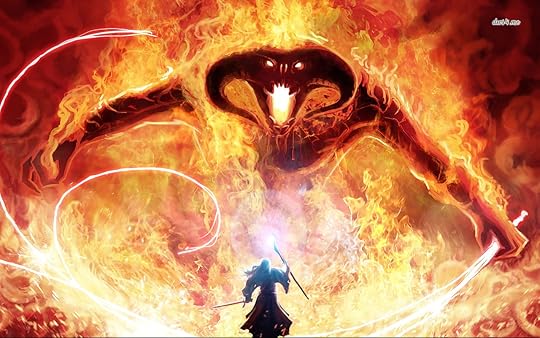
One artist’s depiction of the Balrog confronting Gandolf in “The Lord of the Rings” by J.R.R. Tolkien
Recently in my Tolkien Literature Reading Group, one of the members asked me what I, “as a writer,” thought about a certain scene in The Lord of the Rings. I think it was the scene where Gandolf confronts the Balrog in Moria. Tolkien simply says that the Balrog “was like a great shadow, in the middle of which was a dark form, of man-shape maybe, yet greater” with a mane, a sword, and wings. Gandolf defies it, claiming his status as “a servant of the Secret Fire, wielder of the flame of Anor.” Tolkien doesn’t bother to tell us what the source of this Secret Fire is nor what the flame of Anor is. Each reader is left to imagine the details of the Balrog; it was only in the various film interpretations of the LOTR that viewers were passively fed the Balrog’s details because film required the visual presentation of the Balrog in all its fearsome glory.
I realized that Tolkien, in that particular scene and in many others as well (once I thought about it), did not say nearly as much as most readers think he does in terms of description and detail. He writes JUST ENOUGH and then lets us — each reader — fill in the details. That way each of us is more invested in the scene, in what happens, and in what results come of it. We supply our own vision of beauty and ugliness, what is frightening or comforting, what propels or inhibits the characters.
Too often writers supply too much — too much description, too many motivations, too many words. We need to trust readers more to fill in these details themselves. We overwrite. We over-describe. We need to allow the reader(s) to contribute their own efforts to fill in the gaps and make the scene more compelling. All too often, this is what happens anyway: we can describe a character’s exact appearance, down to the last detail, but the reader will recreate them in whatever way seems appropriate to that reader in order to make the character “beautiful” or “sneaky” or whatever the character’s most important trait is. (I remember that I first read The Hobbit immediately after finishing The Wind in the Willows and I have always pictured Bilbo as a rather large frog wearing Victorian clothes in many scenes, simply another version of Mr. Toad.)
Allowing the reader to contribute to the scene not only makes the scene much more effective but helps us writers to become better writers as well. It might seem lazy to say less about a character or a scene but it actually forces us to be more thoughtful and concise. It makes us think about what is really important about the scene or character and drop anything extraneous.
THAT’S the hard part!
The post Balrogs … and “Less is More!” appeared first on Stephen Morris, author.
May 29, 2017
Windows of Christ Church Cathedral
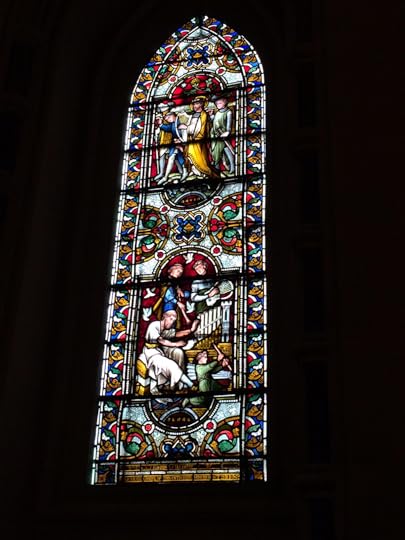
A window of stained glass in Christ Church Cathedral, Dublin (photo by Stephen Morris)

Anothr stained glass window in Christ Church Cathedral, Dublin (photo by Stephen Morris)
The first version of Christ Church Cathedral in Dublin was built of wood just after AD 1028 by the Viking king Sitric Silkenbeard–doesn’t that tell you a lot about him already? It sounds like he could have been Santa Claus! The stone church which is still standing was built by Strongbow and the English in AD 1170 as part of their attempt to invade and subjugate Ireland. The beautiful stained glass windows we see today were installed during the renovations of AD 1871-1878.
Traditionally, the stained glass windows of Gothic churches depict saints or biblical scenes that tell contrasting stories or somehow comment on each other. For instance, a scene of the Last Supper would often be depicted together with a scene of Moses feeding the people with bread from heaven in the desert or a scene of Eve coming from the side of Adam would be matched with a scene of the Church coming from the side of Christ on the cross. The windows in the nave of Christ Church depict fascinating pairs of saints that are not often paired together.
One window pairs King David playing his harp mourning the death of his friend (lover?) Jonathan with Jubal the great-grandson of Adam who was said to have invented musical instruments like the harp [top photo above]. Another window shows Noah blessing his son Shem after the Flood together with Melchizedek, the priest-king of Jerusalem blessing the patriarch Abraham [bottom photo above]. Another window in the cathedral pair depictions of Adam naming the animals with the murder of Abel, the first shepherd, by his brother Cain.
The unusual pairs of scenes in the windows of Christ Church Cathedral (Dublin) are a fascinating series of sermons in colored glass that illuminate often-ignored aspects of the lives of the characters depicted.
The post Windows of Christ Church Cathedral appeared first on Stephen Morris, author.
May 22, 2017
Noah Gets Drunk After the Flood

These mosaics in the narthex (vestibule) of St. Mark’s Basilica in Venice illustrate part of the story of Noah.
Most people recognize Noah. He built the Ark to save the world from the flood, right? He collected all the animals, two-by-two, and loaded them onto the ark so that they could ride out the flood in safety and after the flood was over, he released them to repopulate the earth. What else is there to know?
Noah’s story continues after the end of the flood. When Noah and his family (wife, three sons, and their wives) came out of the ark, the earth was devestated. One of the first things they had to do was begin farming so that they could have something to eat. As part of the farming project, Noah dug a garden and planted grapes. When the grapes were ripe, he harvested them and made wine. When the wine was ready, Noah began to drink it. And drink it. And DRINK it! The first recorded instance of drunkeness! He got drunk and passed out naked in his tent. Naked.
His son Ham walked into the tent and saw his father naked. He went out and told his brothers Shem and Japheth what he had seen. Rather than leave their father laying naked, Shem and Japeth went into the tent, walking backwards and holding a cloak in front of their eyes so that they would not see their father naked. They covered Noah with the cloak and walked out again. When Noah woke up, he knew–apparently without anyone needing to tell him–what had happened. He was so furious at Ham’s behavior that he cursed Ham’s son Canaan.
Ham had seen his father naked. Not only did he do nothing to cover Noah but he went out and told other people and made fun of Noah for lying around drunk, passed out, and naked on the floor. Because Noah seemed to know what had happened, even without anyone telling him, early Jewish commentary thought that Ham had sexually abused his father in some way that left physical evidence behind and suggested that he had castrated his father. Since he had made it impossible for his father Noah to have any more children, Noah cursed Ham’s son Canaan with slavery to insure that Ham had no legal, property-owning descendants. (This idea was used to justify the Israelite occupation under the leadership of Joshua of the area known as Palestine or Canaan after the Exodus. Since Ham’s descendants were also thought to have populated Egypt and the rest of Africa, the curse of Noah was also used by preachers and politicians in the American South to justify the race-based slavery there.)
Early Christian preachers thought that Ham’s mockery of Noah was more important than “having seen his father naked.” Ham made fun of his father’s shame in public, prefiguring the ridicule Christ would face when dying on a cross. Since Christians respect Christ’s flesh like Shem and Japheth respected the flesh of their father, Ambrose of Milan argued, they too will be blessed. Reluctant to imagine that Noah, a savior like Christ, had been raped or castrated, Christian interpreters offered comparatively mild interpretations of this passage. Still, they were also convinced that Ham—and by extension his son Canaan—were wicked and deserved the harsh punishment they received.
For more about the ways the story of Noah and his sons, read here.
On the roof of the narthex (porch) of St. Mark’s Basilica in Venice are a series of gorgeous Byzantine-style moasiacs illustrating stories from the Old Testament, beginning with the Creation and continuing with the Tower of Babel, the Flood, the lives of Abraham and Joseph, concluding with Moses leading the Israelites through the desert to the Promised Land. The mosaics were made during the 1200s.
The post Noah Gets Drunk After the Flood appeared first on Stephen Morris, author.
May 15, 2017
“il Capitello” and the “Eighth Day”

The tiny shrine or chapel in St. Mark’s Basilica (Venice) known as “Il Capitello.” (photo by Stephen Morris)
The shrine set up against a pillar on the north aisle of the nave in St. Mark’s Basilica is known as “The Capitello.” It shelters a Byzantine painted crucifix, brought to Venice in 1290 from Constantinople and is said to have shed blood; some of this blood is kept in a reliquary on display in the treasury of the basilica. (Nearby is another icon, also brought from Constantinople after the Fourth Crusade in 1204. The icon of the Virgin Nicopeia, also known as “Our Lady Who Brings Victory,” was probably one of the most precious objects taken from Constantinople. This icon of the Virgin Nicopeia was probably the original occupant of the Capitello shrine. The icon was only moved to the nearby chapel during the late 1500s or early 1600s.)
There are Annunciation figures (the angel Gabriel and the Virgin Mary) on the columns supporting the shrine’s roof; these Annunciation figures would match the presence of the Nicopeia icon better than they do the presence of the Cross, although the Annunciation and the Crucifixion were thought to have both occurred on March 25.
The roof (baldacchino) of the shrine itself is octagonal. Many early and medieval Christian buildings were octagons, especially those designed for the celebration of baptism or burial. This was because the number 8 figured prominently in early Christian preaching about the Resurrection and eternity.
St. Basil the Great preaches in the fourth century that “The day of the Lord” is another way to say “eternity.” He points out that if we call it “the day of the Lord,” that does not mean there is another one. It is unique. This eternal, everlasting day, being outside the regular cycle of 7-day weeks, is sometimes itself called the “eighth day.”
“This is the day that the Psalmist calls the eighth day, because it is outside this time of weeks. Thus whether you call it day, or whether you call it eternity, you express the same idea.” (Basil the Great, Hexameron 2)
The story of creation in Genesis does not say “on the first day” in Greek; it reads, “on Day One.” Basil suggests that the “day one” of creation is meant to suggest not only eternity but already anticipates the Resurrection of Christ:
“Thus it is in order that you may carry your thoughts forward towards a future life, that Scripture marks by the word “one” the day which is the type of eternity, the first fruits of days, the contemporary of light, the holy Lord’s day honored by the Resurrection of our Lord. ‘And the evening and the morning were one day.'” (Hexameron 2)
Basil is telling his congregation that every Sunday is the “eighth day,” the day of the Resurrection, and therefore every Sunday – the day on which the Eucharist is celebrated – can be their first experience of eternity.

There are mosaics of griffins on the floor beside The Capitello shrine. Griffins are known for guarding treasure and priceless possessions

The icon of Our Lady Who Brings Victory, stolen from Constantinople after the Fourth Crusade in 1204, was originally enshrined in the “il capitello” shrine in Venice’s Basilica of St. Mark.
The post “il Capitello” and the “Eighth Day” appeared first on Stephen Morris, author.
May 8, 2017
St. Michan’s Church

A view into one of the vaults in the crypt beneath St. Michan’s Church, Dublin (photo by Stephen Morris)

A view of another vault beneath St. Michan’s, in which some of the mummies are exposed. The corpse on the left is an early medieval nun, the one is the middle had a hand cut off (accident? criminal punishment?), and the one on the right is a medieval man.
The church of St. Michan in Dublin is a fascinating place! Dublin was first settled by Danish Vikings (“Dublin” is derived from the Viking word for “Black Pool,” referring to the swampy ground the city was founded on) and Michan was apparently a Danish or Danish-Irish monk from that early 10th-11th century period. The church itself was first built in AD 1095 although the current building was erected in 1686 on the older foundation. It was the only parish church on the north side of the River Liffey (i.e. outside the city walls) for centuries.
In the crypt beneath the church are several vaults that were used to inter the coffins of the dead. These were preserved and expanded during the reconstruction of the building. Many of the coffins in the underground vaults date from the early Middle Ages although many also date from more recent times: leaders of a failed rebellion in 1798 are also interred here.
Because opening a sealed coffin is illegal — it is part of the crime of grave-robbing — no one realized there was anything unusual about the corpses below St. Michan’s until the older coffins began to break open as the weight of the newer coffins stacked atop them became too heavy. The coffins that broke open revealed that the corpses, which had not been treated in any unusual way, had all been mummified and preserved. This was probably due to the limestone used to build the vaults and the methane gas of the swamp below the foundations of Dublin. Limestone absorbs moisture and the constant cool temperature of the vaults helped preserve and mummify the bodies as well. The presence of methane reduces the amount of oxygen in the crypt and therefore reduces the amount of bacteria etc. that leads to more normal decomposition. (We presume that the corpses in the newer coffins are also becoming mummies as well although we won’t know for sure until the newer coffins break open as well. The vaults are still used on occasion for new internments so there is always the possibility of additional weight to break open the coffins that haven’t broken open — yet.)
Bram Stoker is thought to have visited the vaults in the crypt below St. Michan’s and possibly to have found inspiration there for at least a few of the scenes in his classic Dracula.
The church of St. Michan is very near the new Teeling whiskey distillery in Dublin, making a visit to both sites an easy excursion.
The post St. Michan’s Church appeared first on Stephen Morris, author.
May 1, 2017
Dublin & Venice (April 2017)

The Grand Canal in Venice (April 2017, photo by S. Morris)

Sunset on the River Liffey in Dublin (April 2017, photo by S. Morris)

St. Mark’s Square in Venice (April 2017, photo by S. Morris)
I was lucky enough to spend a week in Venice and a week in Dublin during April with my partner Elliot. (We also spent the week in Venice with longtime friends, a couple from New Jersey.) If you follow me on Facebook, you may recognize the photos above. I hope to share a few of my travel experiences in posts here over the next few weeks.
We encountered chill and rainy weather the first day in Venice but the rest of the trip was warm and sunny in Venice; the weather was a bit chilly in Dublin but fairly dry, although there was a brief and sudden hailstorm at one point!
Venice calls out for a novel to be set there. Parts of Ireland have already appeared in Come Hell or High Water and additional regions of Ireland will be the setting of the novel I am currently working on (Earth to Earth, Ashes to Ashes); there could easily be additional novels set in Ireland as well.
There was a surprising similarity between Dublin and Venice that I had not expected. Each city is beautiful, although in very different ways. Both have legends and ancient tales stalking the shadows of their streets. But both also depend on the water for their history and existence. Both were built on swamps and mud flats, although the ground beneath Dublin is somewhat more solid than that under Venice. Both feature a variety of fish and seafood in their traditional cuisines (making them perhaps strange places to go after the long weeks of no meat and only fish during Lent). 



